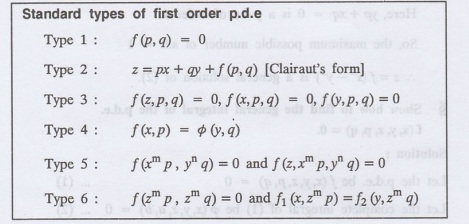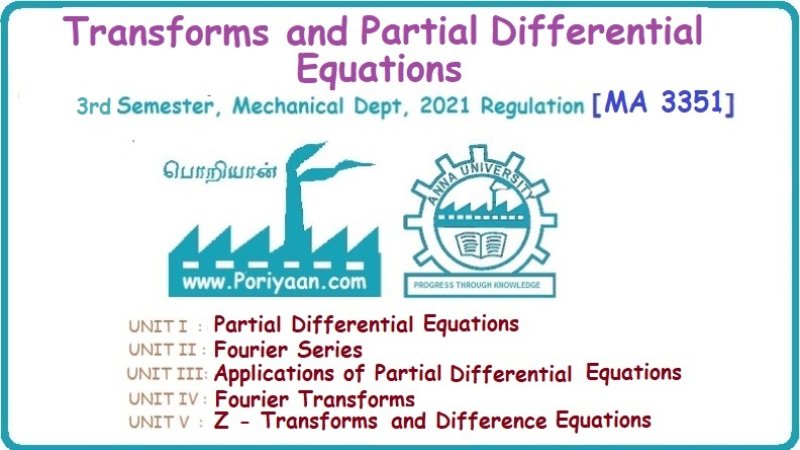Transforms And Partial Differential Equations: UNIT I: Partial Differential Equations
Methods to solve the first order partial differential equation
A solution which contains as many arbitrary constants as there are independent variables is called a complete integral (or) complete solution. (number of a.c. = number of I.V)
(2) Methods to solve the first order
partial differential equation.
The general form of a first order
partial differential equation is 
§
Mention three types of solution of a p.d.e. (or) Define P.I, general and
complete integrals of a p.d.e.
1.
Complete integral (or) Complete solution
A solution which contains as many
arbitrary constants as there are independent variables is called a complete
integral (or) complete solution. (number of a.c. = number of I.V)
2.
Particular integral (or) Particular solution
A solution obtained by giving
particular values to the arbitrary constants in a complete integral is called a
particular integral (or) particular solution.
3.
General integral (or) General solution
A solution of a p.d.e. which
contains the maximum possible number of arbitrary functions is called a general
integral (or) general solution.

Example
(i):
z = ax + by + ab
Number of a.c = Number of I.V
Hence, z = ax + by + ab is a
complete integral.
Example (ii) : z = 2x + 3y+6 is a
particular integral.
Since, a = 2, b = 3 are the
particular values of the complete integral z = ax + by + ab
Example (iii) :
z = ƒ (x2 − y2)
... (1) is the solution of p.d.e
yp + xq = 0... (2)
Here, yp +xq = 0 is a p.d.e of
order 1.
So, the maximum possible number of
a.f. = 1
z = f(x2 - y2) is a general
solution of (2).
§
Show how to find the general integral of the p.d.e. f(x, y, z, p, q) = 0.
Solution
:
Let the p.d.e be f(x,y,z,p,q) = 0 ……….(1)
Let the complete integral of (1) be
p (x, y, z, a,b) = 0 ... (2)
where a & b are arbitrary
constants.
Suppose, in (2) one of the
constants is a function of the other say b = f(a). Then (2) becomes

Differentiating (3) p.w.r. to a we
get

The elimination of 'a' between (3)
& (4) if it exists, called the general integral of (1).
§
Define singular integral.
Solution:
Let f (x, y, z,p,q) = 0……………(1)
Let the complete integral be (x, y,
z,a,b)………………..(2)
Differentiating (2) p.w.r. to a and
b in turn we get,

The elimination of a & b from
the three equations (2), (3) & (4) if it exists, is called the singular
integral.

Type
1 f(p, q) = 0
Suppose that z = ax + by + c
Then p = a, q=b
we get, f (a, b) = 0
solving for b, we get b = ϕ(a)
z= ax + ϕ(a)y + c ………………(1)
which is the required complete
integral.
Differentiating (1) p. w.r.to c, we
get 0 = 1 which is absurd that there is no singular integral.
Put cf (a) in (1) we get
z = ax + (a) y + f (a)………………(2)
Differentiating (2) p. w.r.to a we
get
0 = x + ᴓ (a)y + f (a) ……(3)
eliminating 'a' between (2) and
(3), we get the general solution.
Transforms And Partial Differential Equations: UNIT I: Partial Differential Equations : Tag: : - Methods to solve the first order partial differential equation
Related Topics
Related Subjects
Transforms and Partial Differential Equations
MA3351 3rd semester civil, Mechanical Dept | 2021 Regulation | 3rd Semester Mechanical Dept 2021 Regulation
